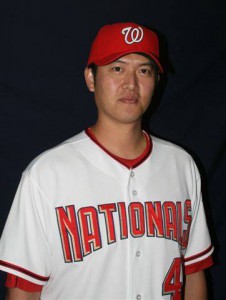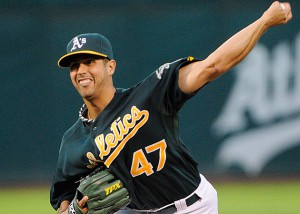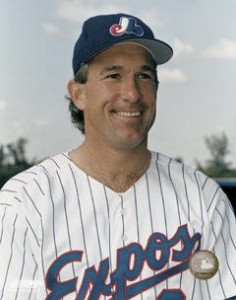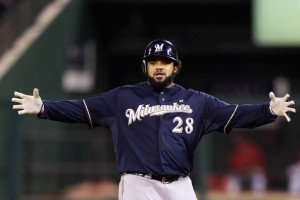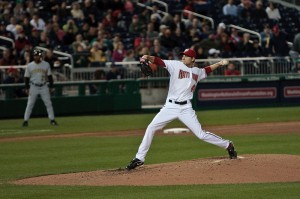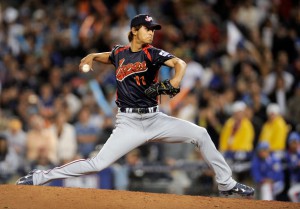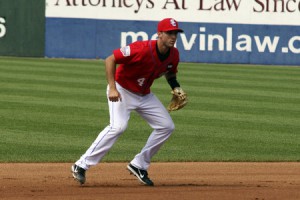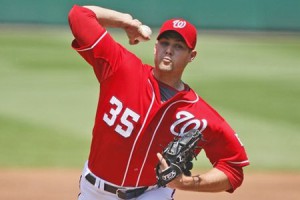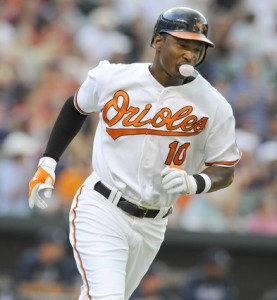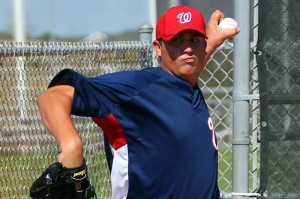
Solis’ TJ surgery news thins our already-too-thin starting pitching minor league depth. Photo via Natsinsider blog/Mark Zuckerman
With Spring Training in full swing, most of the focus is on the Nationals 25-man roster and who may or may not make it. Even with the additions to the major league roster, our minor league starter development is still incredibly important to this team for the long run. Despite having Strasburg, Zimmermann and Gonzalez each locked up for many years (roughly, 2016, 2016 and 2018 respectively with options exercised), the rest of the rotation is not exactly set in stone for the long run. Wang and Jackson are on one-year FA contracts and Lannan doesn’t seem a lock to be tendered this coming off season (where he’ll face arbitration for the third time and, if he stays here and puts in 30 starts, could be in line for something close to $8M in 2013). That is, if Lannan is still even with the team in a year’s time (he seems surplus to requirements right now and may be a trade candidate).
Even more importantly, three key starters in our farm system went the other way for Gonzalez. Our 2012 AAA starter safety net of Milone and Peacock is now set to be the 4th and 5th starter in Oakland, and our most electric younger arm (Cole) is now one of Billy Beane‘s best prospects.
That being said, lets talk about what the 2012 minor league rotations may look like, and where interest may lie with up and coming arms. Experienced readers will note that, by and large, I only focus on minor league starters. That is because, for the very large part, that pitchers rise up in the minors as starters and only get converted to be relievers upon failing as starters. If you look at our current bullpen; Clippard, Rodriguez, Burnett, Gorzelanny, Detwiler and Lidge are all former starters, converted to being relievers either because of poor performance or for physical reasons. Only Storen has grown up entirely as a reliever. Therefore, the odds of a guy who is already pitching in relief in the lower minors rising up to be a part of the MLB bullpen is relatively slim. Loogies? Another matter, but still a difficult path (just ask someone like Josh Smoker). Therefore, I tend to focus on Starters with occasional lip service given to closers per level and other relievers who are pitching their way into promotions.
Luke Erickson has posted some predictions (for AAA, AA, high-A and low-A), I put in an updated guess on Syracuse’s rotation post Gonzalez trade, and I had a series of posts at the end of last season wrapping up each level with predictions for 2012. From all those posts, here’s my preliminary guesses on the rotations for the minor league rotations:
- AAA: Stammen, Maya, Arneson, Ballard, Buschmann
I wouldn’t be surprised to see Erickson’s guesses of Atkins and Hernandez though replacing the last two; I’m guessing there’s going to be a wide-open competition for this rotation in this year’s spring training. And, I specifically did not include John Lannan here; I just cannot believe the team is going to stick him in Syracuse by virtue of his option after signing on to pay him $5M.
First man promoted: I’d guess Stammen, who did have some successes in last year’s call-up, but it’ll take a swine-flu epidemic in the Nationals clubhouse for him to get called up to make some starts. The MLB staff looks to have two former starters in their bullpen who will get the ball before Stammen gets a shot in 2012, and that doesn’t include the Wang/Lannan 5th starter conundrum.
First man demoted to the bullpen: Arneson; he’s bounced our system around like a pinball lately, and the team seems to use him as a multi-level handy-man instead of a starter prospect.
- AA: Rosenbaum, Bronson, Demny, Gilliam, Olbrychowski
This list did have Sammy Solis until his TJ surgery was announced, and I put in Olbrychowski, who was halfway decent in a bunch of 2nd half starts in 2011. I do think Roark is done being a starter in this system but I could be wrong. Gilliam was the little-known make-weight player in the Gonzalez trade and I think he makes it to the Harrisburg roster.
First man promoted: Danny Rosenbaum, who aced Potomac last year and has the same make up as Lannan. But, unfortunately there’s no top-10 stars on this list that could make an immediate impact.
First man demoted to the bullpen: Obrychowski, who started 2011 in the pen and may be on a short leash if someone in Potomac lights it up.
- High-A: Purke, Meyer, Selik, Grace, Hill
I think Purke is advanced enough to start here, as is Meyer. Of course, I also think Purke’s injury history could work against him and he ends up in extended spring for a bit. Either way, I think both would be poorly served by sticking them in Low-A. They’re both first round talents and need to be going against older, more advanced hitters right now. This rotation is the future for the Nats; if they can’t find a 2014 starter out of this group, then we’ll be spending a ton in the FA pitching market for years to come. This rotation is hurt by the loss of Taylor Jordan, who will be out the entirety of 2012 with TJ surgery after pitching very effectively for the first half of 2011 for Hagerstown. Hill is the name i’m least confident in, only putting him here by virtue of his being a senior draftee in 2011, thus he’d be at least 3 years too old for low-A this year.
First man promoted: Cameron Selik; the phenom from 2011’s Hagerstown staff already has a ton of Potomac experience and could move up soon. Despite their promise, I think both Purke and Meyers will be in Potomac for at least a half a season to get their professional legs.
First man demoted to the bullpen: Grace: he wasn’t entirely convincing as a starter in low-A, but his numbers were skewed by one or two really bad outings.
- Low-A: Turnbull, Hansen, Ray, McGeary, Karns?
Maybe the 5th would be Karns, who if healthy could be a quick riser after so many injuries have derailed what was a promising young arm. I think Ray starts here again with the idea of quickly promoting him, despite his success here last year. He’s still young. Of course, I could also see Ray and Hill switching places between low- and high-A.
First man promoted: Robbie Ray: he out pitched AJ Cole last year without any of the Baseball America top 100 love. I think he’s the next in a long line of lower velocity but higher result lefty starters that the system has been developing (see Lannan, Detwiler to a certain extent, Solis, Rosenbaum and McGeary for comps).
First man demoted to the bullpen: Karns, if he’s here. I’m guessing Karns has this season to show that he continues to be a starter prospect, with a back-of-the-bullpen job waiting if he can’t show he’s durable enough to go 6 innings every 5 days.
- Short-A: MRodriguez, Dupra, Baez and 2 draft picks.
- GCL: Mieses repeating plus 4 guys from DSL and the 2012 draft.
There’s almost no point of trying to predict the short season rotations, but I do believe that the names listed here aren’t going to make the Low-A roster but are still worth keeping as starters in extended spring. We had almost no starter talent in the GCL last season, with only Mieses making enough of an impression to keep him in that role.
Lastly, Taylor Jordan and Sammy Solis start the year on the DL, unfortunately, both with Tommy John surgery. They would have both been prominent members of their rotations after great seasons last year, and their injuries further thin our starting pitching depth post Gonzalez trade.
